Analysis of Nike's Procurement and Supply Chain Management
VerifiedAdded on 2023/06/14
|15
|3797
|427
Report
AI Summary
This report provides an in-depth analysis of Nike's procurement and supply chain management, examining various aspects such as supply analysis, operations analysis, information analysis, integration analysis, and sustainability analysis. It delves into Nike's mission, vision, and strategic goals, highlighting the company's key suppliers and their geographical dispersion. The report evaluates Nike's demand forecasting and inventory management techniques, including the Just In Time approach, and discusses challenges like the bullwhip effect. Furthermore, it assesses Nike's integration level using a 9-step framework and the Triple-A approach, emphasizing the company's agility, adaptability, and alignment. The sustainability analysis explores Nike's efforts in environmental protection and employee motivation. The report concludes by discussing improvement programs that can assist Nike in achieving its strategic goals and maintaining its position in the competitive market.
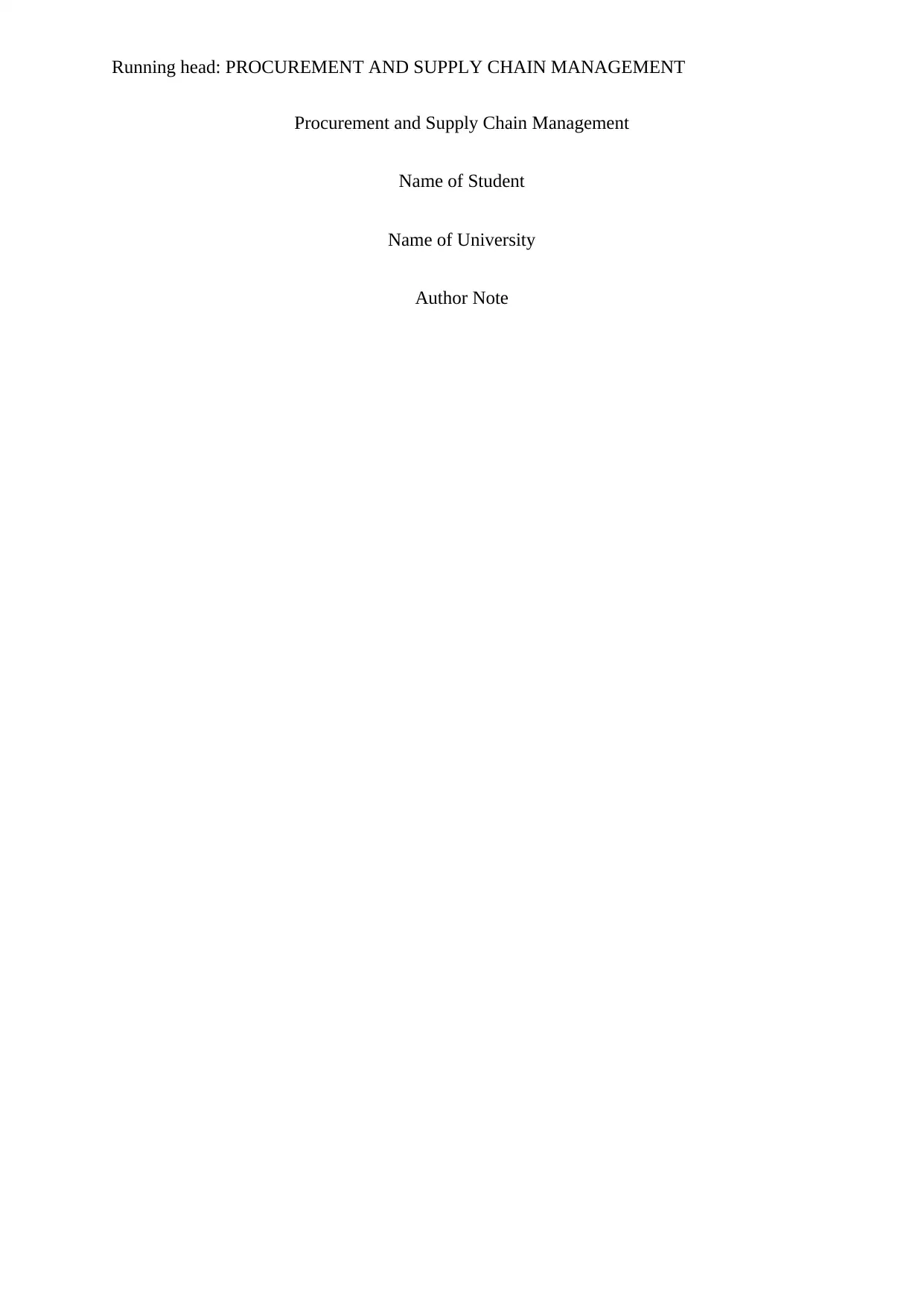
Running head: PROCUREMENT AND SUPPLY CHAIN MANAGEMENT
Procurement and Supply Chain Management
Name of Student
Name of University
Author Note
Procurement and Supply Chain Management
Name of Student
Name of University
Author Note
Paraphrase This Document
Need a fresh take? Get an instant paraphrase of this document with our AI Paraphraser

1
PROCUREMENT AND SUPPLY CHAIN MANAGEMENT
Table of contents
Vision, mission and strategic goals of Nike...............................................................................3
Part A: Findings of supply analysis...........................................................................................3
Part B: Findings of operations analysis......................................................................................4
Part C: Findings of information analysis...................................................................................5
Part D: Findings of integration analysis.....................................................................................6
Part E: Findings of sustainability analysis.................................................................................6
Discussion of Nike's procurement and supply chain analysis....................................................7
Discussion of improvement programs.......................................................................................9
Improvement programs assisting Nike to achieve its vision, mission and strategic goals......10
Conclusion................................................................................................................................11
Reference..................................................................................................................................12
PROCUREMENT AND SUPPLY CHAIN MANAGEMENT
Table of contents
Vision, mission and strategic goals of Nike...............................................................................3
Part A: Findings of supply analysis...........................................................................................3
Part B: Findings of operations analysis......................................................................................4
Part C: Findings of information analysis...................................................................................5
Part D: Findings of integration analysis.....................................................................................6
Part E: Findings of sustainability analysis.................................................................................6
Discussion of Nike's procurement and supply chain analysis....................................................7
Discussion of improvement programs.......................................................................................9
Improvement programs assisting Nike to achieve its vision, mission and strategic goals......10
Conclusion................................................................................................................................11
Reference..................................................................................................................................12

2
PROCUREMENT AND SUPPLY CHAIN MANAGEMENT
Executive Summary
The report highlights the importance of procurement and supply chain management that is
followed by organisations. For the purpose of the report, Nike has been considered and the
manner in which the company applies itself in developing its supply chain management are
thoroughly analysed. Nike is a reputed footwear manufacturing company headquartered in
the USA. The application of Bullwhip effects and Dynamic Alignment model has been used
to understand the effectiveness of the strategies that have been used by the company.
Recommendations are provided that highlight the manner in which the improved program
adopted by Nike can help in its growth and strategic development.
PROCUREMENT AND SUPPLY CHAIN MANAGEMENT
Executive Summary
The report highlights the importance of procurement and supply chain management that is
followed by organisations. For the purpose of the report, Nike has been considered and the
manner in which the company applies itself in developing its supply chain management are
thoroughly analysed. Nike is a reputed footwear manufacturing company headquartered in
the USA. The application of Bullwhip effects and Dynamic Alignment model has been used
to understand the effectiveness of the strategies that have been used by the company.
Recommendations are provided that highlight the manner in which the improved program
adopted by Nike can help in its growth and strategic development.
⊘ This is a preview!⊘
Do you want full access?
Subscribe today to unlock all pages.

Trusted by 1+ million students worldwide

3
PROCUREMENT AND SUPPLY CHAIN MANAGEMENT
Vision, mission and strategic goals of Nike
The mission of Nike is ensuring that every athlete in the world is inspired and acts in
an innovative manner while performing in the field.
The vision statement of the company is to assist Nike Incorporated and the customers
to thrive in a sustainable environment. The sustainable economy is aimed at creating a
balance between profit, people and planet.
The strategic goal of Nike is to believe in the partnership that has been formed and
provide value to work with every stakeholder in a cordial manner by sharing the best
practices (Nike.com, 2018).
Part A: Findings of supply analysis
The procurement department of Nike needs to manage the different types of footwear
that are manufactured by Nike. The key products of the company are the various types of
footwear that are manufactured. These need to be managed so that the company can conduct
itself properly in the competitive environment.
The key suppliers of Nike include Pou Chen Corporation, PT Pan Brothers TBK,
Fulgent Sun International Holding Company and so on. These suppliers are famous
worldwide and serve the company in every geographic location. According to Fernie and
Sparks (2014), Nike has a worldwide reputation and the company is spread in every
geographical dispersion.
Currently, the supply market of Nike has lost its charm in the international market.
Issues have been seen in some of the shoes that the company manufactures have had certain
PROCUREMENT AND SUPPLY CHAIN MANAGEMENT
Vision, mission and strategic goals of Nike
The mission of Nike is ensuring that every athlete in the world is inspired and acts in
an innovative manner while performing in the field.
The vision statement of the company is to assist Nike Incorporated and the customers
to thrive in a sustainable environment. The sustainable economy is aimed at creating a
balance between profit, people and planet.
The strategic goal of Nike is to believe in the partnership that has been formed and
provide value to work with every stakeholder in a cordial manner by sharing the best
practices (Nike.com, 2018).
Part A: Findings of supply analysis
The procurement department of Nike needs to manage the different types of footwear
that are manufactured by Nike. The key products of the company are the various types of
footwear that are manufactured. These need to be managed so that the company can conduct
itself properly in the competitive environment.
The key suppliers of Nike include Pou Chen Corporation, PT Pan Brothers TBK,
Fulgent Sun International Holding Company and so on. These suppliers are famous
worldwide and serve the company in every geographic location. According to Fernie and
Sparks (2014), Nike has a worldwide reputation and the company is spread in every
geographical dispersion.
Currently, the supply market of Nike has lost its charm in the international market.
Issues have been seen in some of the shoes that the company manufactures have had certain
Paraphrase This Document
Need a fresh take? Get an instant paraphrase of this document with our AI Paraphraser
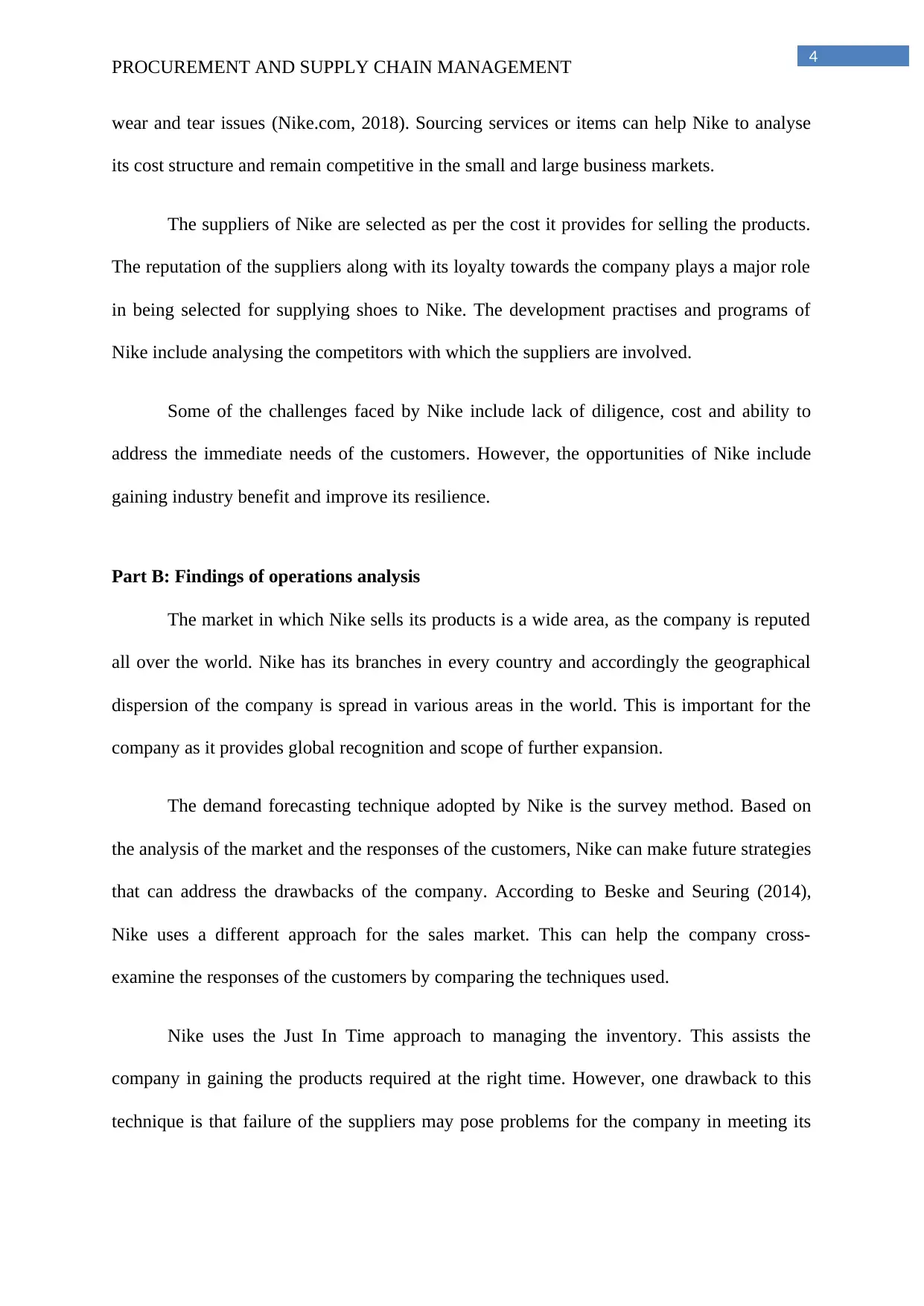
4
PROCUREMENT AND SUPPLY CHAIN MANAGEMENT
wear and tear issues (Nike.com, 2018). Sourcing services or items can help Nike to analyse
its cost structure and remain competitive in the small and large business markets.
The suppliers of Nike are selected as per the cost it provides for selling the products.
The reputation of the suppliers along with its loyalty towards the company plays a major role
in being selected for supplying shoes to Nike. The development practises and programs of
Nike include analysing the competitors with which the suppliers are involved.
Some of the challenges faced by Nike include lack of diligence, cost and ability to
address the immediate needs of the customers. However, the opportunities of Nike include
gaining industry benefit and improve its resilience.
Part B: Findings of operations analysis
The market in which Nike sells its products is a wide area, as the company is reputed
all over the world. Nike has its branches in every country and accordingly the geographical
dispersion of the company is spread in various areas in the world. This is important for the
company as it provides global recognition and scope of further expansion.
The demand forecasting technique adopted by Nike is the survey method. Based on
the analysis of the market and the responses of the customers, Nike can make future strategies
that can address the drawbacks of the company. According to Beske and Seuring (2014),
Nike uses a different approach for the sales market. This can help the company cross-
examine the responses of the customers by comparing the techniques used.
Nike uses the Just In Time approach to managing the inventory. This assists the
company in gaining the products required at the right time. However, one drawback to this
technique is that failure of the suppliers may pose problems for the company in meeting its
PROCUREMENT AND SUPPLY CHAIN MANAGEMENT
wear and tear issues (Nike.com, 2018). Sourcing services or items can help Nike to analyse
its cost structure and remain competitive in the small and large business markets.
The suppliers of Nike are selected as per the cost it provides for selling the products.
The reputation of the suppliers along with its loyalty towards the company plays a major role
in being selected for supplying shoes to Nike. The development practises and programs of
Nike include analysing the competitors with which the suppliers are involved.
Some of the challenges faced by Nike include lack of diligence, cost and ability to
address the immediate needs of the customers. However, the opportunities of Nike include
gaining industry benefit and improve its resilience.
Part B: Findings of operations analysis
The market in which Nike sells its products is a wide area, as the company is reputed
all over the world. Nike has its branches in every country and accordingly the geographical
dispersion of the company is spread in various areas in the world. This is important for the
company as it provides global recognition and scope of further expansion.
The demand forecasting technique adopted by Nike is the survey method. Based on
the analysis of the market and the responses of the customers, Nike can make future strategies
that can address the drawbacks of the company. According to Beske and Seuring (2014),
Nike uses a different approach for the sales market. This can help the company cross-
examine the responses of the customers by comparing the techniques used.
Nike uses the Just In Time approach to managing the inventory. This assists the
company in gaining the products required at the right time. However, one drawback to this
technique is that failure of the suppliers may pose problems for the company in meeting its
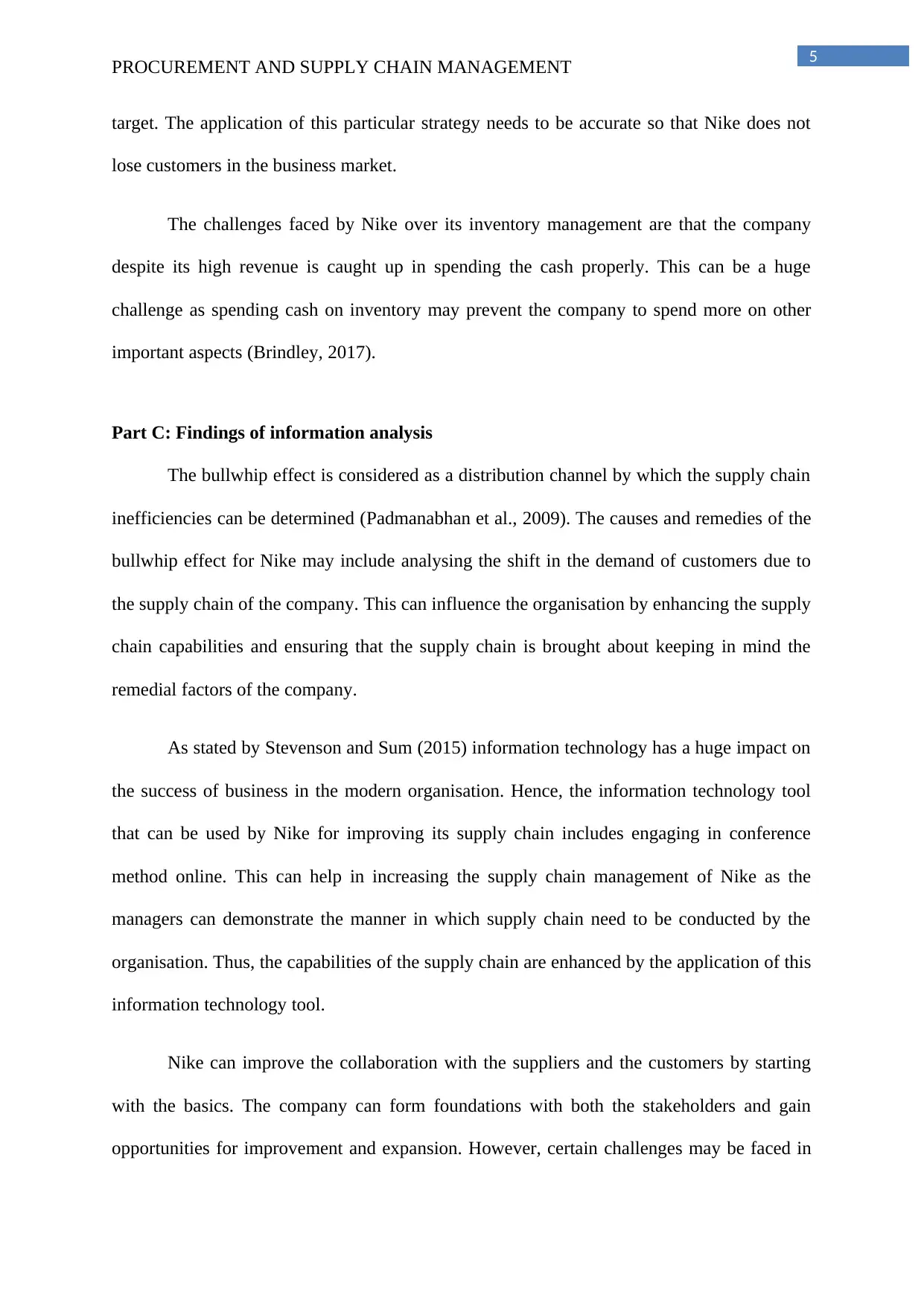
5
PROCUREMENT AND SUPPLY CHAIN MANAGEMENT
target. The application of this particular strategy needs to be accurate so that Nike does not
lose customers in the business market.
The challenges faced by Nike over its inventory management are that the company
despite its high revenue is caught up in spending the cash properly. This can be a huge
challenge as spending cash on inventory may prevent the company to spend more on other
important aspects (Brindley, 2017).
Part C: Findings of information analysis
The bullwhip effect is considered as a distribution channel by which the supply chain
inefficiencies can be determined (Padmanabhan et al., 2009). The causes and remedies of the
bullwhip effect for Nike may include analysing the shift in the demand of customers due to
the supply chain of the company. This can influence the organisation by enhancing the supply
chain capabilities and ensuring that the supply chain is brought about keeping in mind the
remedial factors of the company.
As stated by Stevenson and Sum (2015) information technology has a huge impact on
the success of business in the modern organisation. Hence, the information technology tool
that can be used by Nike for improving its supply chain includes engaging in conference
method online. This can help in increasing the supply chain management of Nike as the
managers can demonstrate the manner in which supply chain need to be conducted by the
organisation. Thus, the capabilities of the supply chain are enhanced by the application of this
information technology tool.
Nike can improve the collaboration with the suppliers and the customers by starting
with the basics. The company can form foundations with both the stakeholders and gain
opportunities for improvement and expansion. However, certain challenges may be faced in
PROCUREMENT AND SUPPLY CHAIN MANAGEMENT
target. The application of this particular strategy needs to be accurate so that Nike does not
lose customers in the business market.
The challenges faced by Nike over its inventory management are that the company
despite its high revenue is caught up in spending the cash properly. This can be a huge
challenge as spending cash on inventory may prevent the company to spend more on other
important aspects (Brindley, 2017).
Part C: Findings of information analysis
The bullwhip effect is considered as a distribution channel by which the supply chain
inefficiencies can be determined (Padmanabhan et al., 2009). The causes and remedies of the
bullwhip effect for Nike may include analysing the shift in the demand of customers due to
the supply chain of the company. This can influence the organisation by enhancing the supply
chain capabilities and ensuring that the supply chain is brought about keeping in mind the
remedial factors of the company.
As stated by Stevenson and Sum (2015) information technology has a huge impact on
the success of business in the modern organisation. Hence, the information technology tool
that can be used by Nike for improving its supply chain includes engaging in conference
method online. This can help in increasing the supply chain management of Nike as the
managers can demonstrate the manner in which supply chain need to be conducted by the
organisation. Thus, the capabilities of the supply chain are enhanced by the application of this
information technology tool.
Nike can improve the collaboration with the suppliers and the customers by starting
with the basics. The company can form foundations with both the stakeholders and gain
opportunities for improvement and expansion. However, certain challenges may be faced in
⊘ This is a preview!⊘
Do you want full access?
Subscribe today to unlock all pages.

Trusted by 1+ million students worldwide
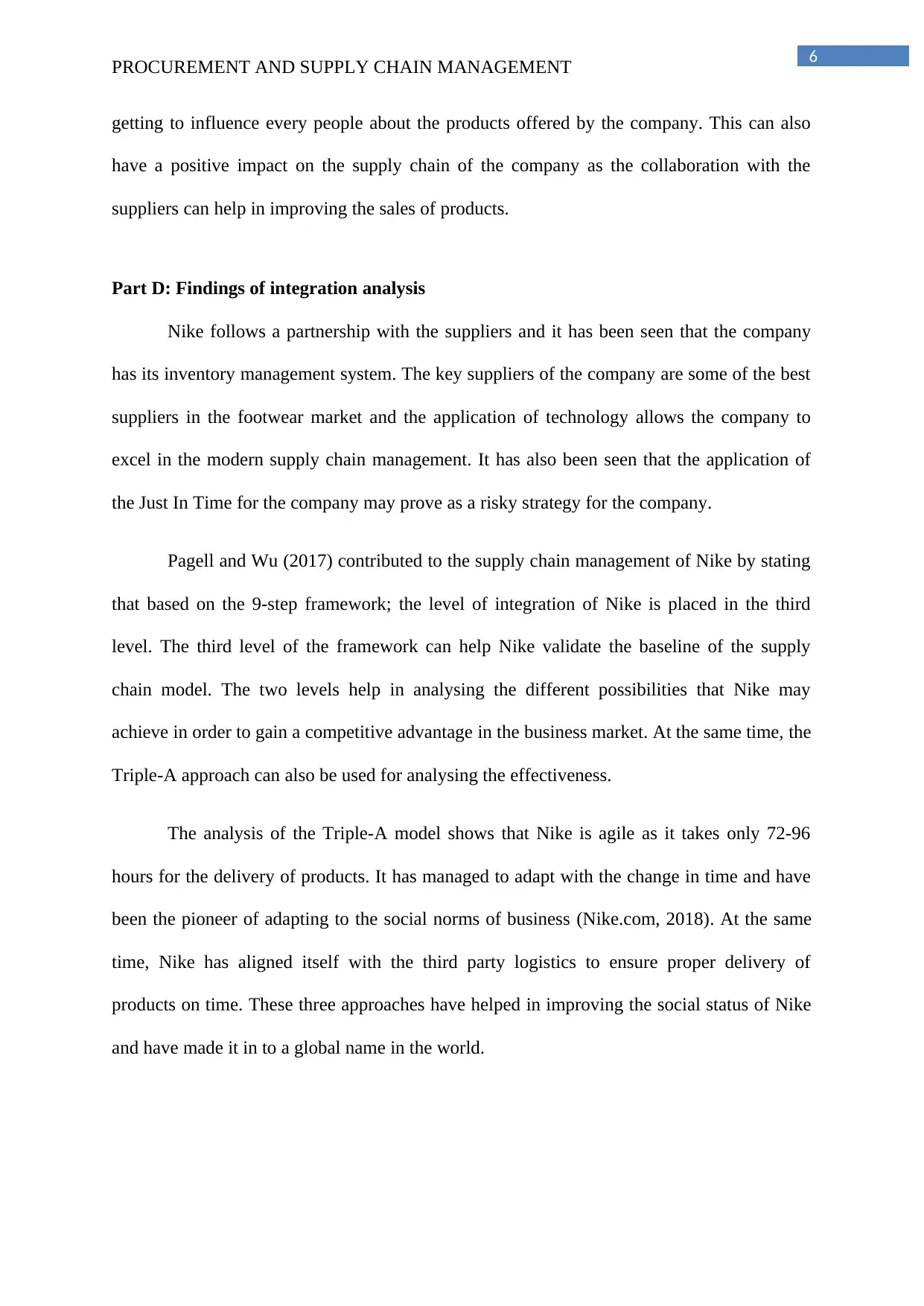
6
PROCUREMENT AND SUPPLY CHAIN MANAGEMENT
getting to influence every people about the products offered by the company. This can also
have a positive impact on the supply chain of the company as the collaboration with the
suppliers can help in improving the sales of products.
Part D: Findings of integration analysis
Nike follows a partnership with the suppliers and it has been seen that the company
has its inventory management system. The key suppliers of the company are some of the best
suppliers in the footwear market and the application of technology allows the company to
excel in the modern supply chain management. It has also been seen that the application of
the Just In Time for the company may prove as a risky strategy for the company.
Pagell and Wu (2017) contributed to the supply chain management of Nike by stating
that based on the 9-step framework; the level of integration of Nike is placed in the third
level. The third level of the framework can help Nike validate the baseline of the supply
chain model. The two levels help in analysing the different possibilities that Nike may
achieve in order to gain a competitive advantage in the business market. At the same time, the
Triple-A approach can also be used for analysing the effectiveness.
The analysis of the Triple-A model shows that Nike is agile as it takes only 72-96
hours for the delivery of products. It has managed to adapt with the change in time and have
been the pioneer of adapting to the social norms of business (Nike.com, 2018). At the same
time, Nike has aligned itself with the third party logistics to ensure proper delivery of
products on time. These three approaches have helped in improving the social status of Nike
and have made it in to a global name in the world.
PROCUREMENT AND SUPPLY CHAIN MANAGEMENT
getting to influence every people about the products offered by the company. This can also
have a positive impact on the supply chain of the company as the collaboration with the
suppliers can help in improving the sales of products.
Part D: Findings of integration analysis
Nike follows a partnership with the suppliers and it has been seen that the company
has its inventory management system. The key suppliers of the company are some of the best
suppliers in the footwear market and the application of technology allows the company to
excel in the modern supply chain management. It has also been seen that the application of
the Just In Time for the company may prove as a risky strategy for the company.
Pagell and Wu (2017) contributed to the supply chain management of Nike by stating
that based on the 9-step framework; the level of integration of Nike is placed in the third
level. The third level of the framework can help Nike validate the baseline of the supply
chain model. The two levels help in analysing the different possibilities that Nike may
achieve in order to gain a competitive advantage in the business market. At the same time, the
Triple-A approach can also be used for analysing the effectiveness.
The analysis of the Triple-A model shows that Nike is agile as it takes only 72-96
hours for the delivery of products. It has managed to adapt with the change in time and have
been the pioneer of adapting to the social norms of business (Nike.com, 2018). At the same
time, Nike has aligned itself with the third party logistics to ensure proper delivery of
products on time. These three approaches have helped in improving the social status of Nike
and have made it in to a global name in the world.
Paraphrase This Document
Need a fresh take? Get an instant paraphrase of this document with our AI Paraphraser
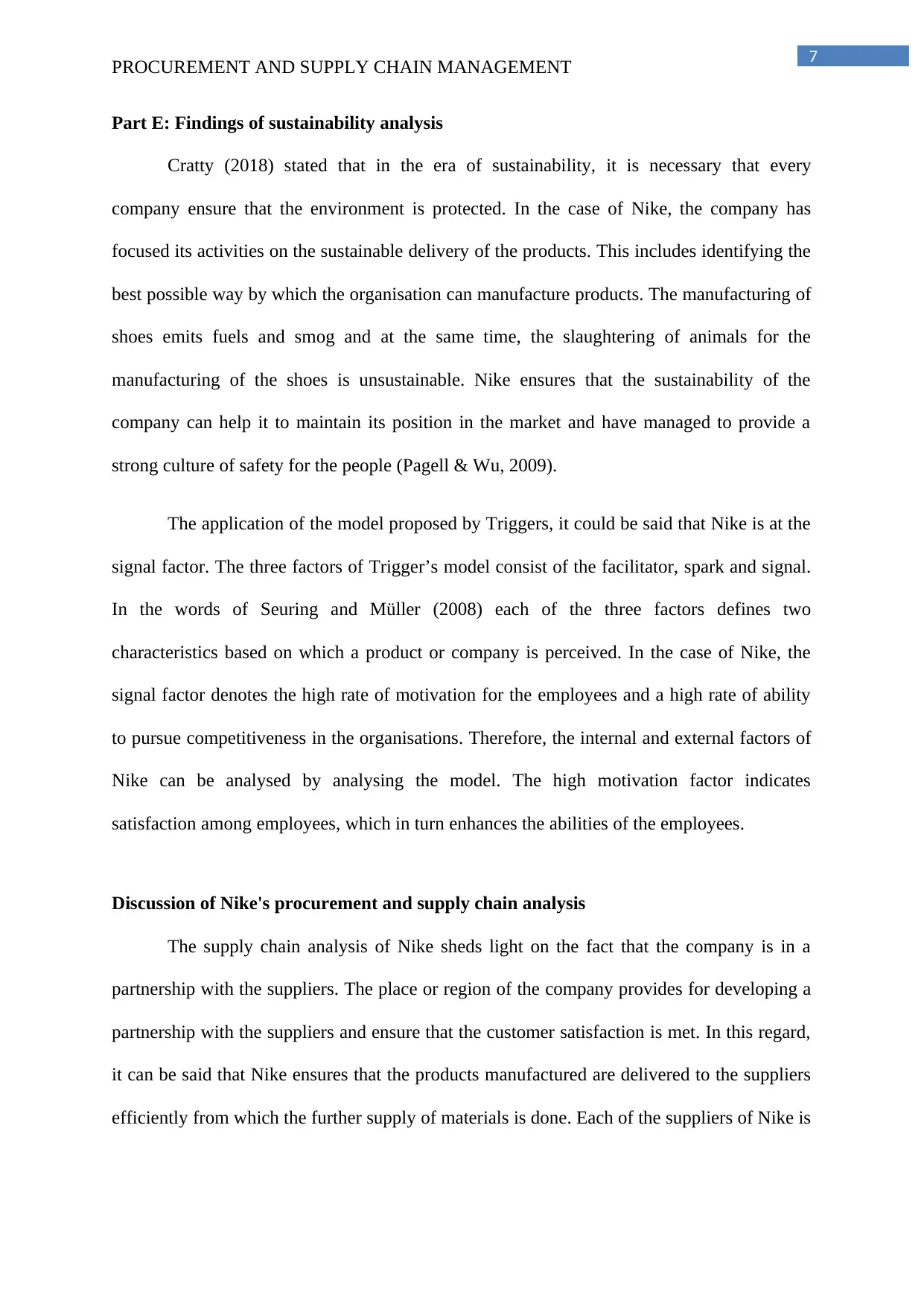
7
PROCUREMENT AND SUPPLY CHAIN MANAGEMENT
Part E: Findings of sustainability analysis
Cratty (2018) stated that in the era of sustainability, it is necessary that every
company ensure that the environment is protected. In the case of Nike, the company has
focused its activities on the sustainable delivery of the products. This includes identifying the
best possible way by which the organisation can manufacture products. The manufacturing of
shoes emits fuels and smog and at the same time, the slaughtering of animals for the
manufacturing of the shoes is unsustainable. Nike ensures that the sustainability of the
company can help it to maintain its position in the market and have managed to provide a
strong culture of safety for the people (Pagell & Wu, 2009).
The application of the model proposed by Triggers, it could be said that Nike is at the
signal factor. The three factors of Trigger’s model consist of the facilitator, spark and signal.
In the words of Seuring and Müller (2008) each of the three factors defines two
characteristics based on which a product or company is perceived. In the case of Nike, the
signal factor denotes the high rate of motivation for the employees and a high rate of ability
to pursue competitiveness in the organisations. Therefore, the internal and external factors of
Nike can be analysed by analysing the model. The high motivation factor indicates
satisfaction among employees, which in turn enhances the abilities of the employees.
Discussion of Nike's procurement and supply chain analysis
The supply chain analysis of Nike sheds light on the fact that the company is in a
partnership with the suppliers. The place or region of the company provides for developing a
partnership with the suppliers and ensure that the customer satisfaction is met. In this regard,
it can be said that Nike ensures that the products manufactured are delivered to the suppliers
efficiently from which the further supply of materials is done. Each of the suppliers of Nike is
PROCUREMENT AND SUPPLY CHAIN MANAGEMENT
Part E: Findings of sustainability analysis
Cratty (2018) stated that in the era of sustainability, it is necessary that every
company ensure that the environment is protected. In the case of Nike, the company has
focused its activities on the sustainable delivery of the products. This includes identifying the
best possible way by which the organisation can manufacture products. The manufacturing of
shoes emits fuels and smog and at the same time, the slaughtering of animals for the
manufacturing of the shoes is unsustainable. Nike ensures that the sustainability of the
company can help it to maintain its position in the market and have managed to provide a
strong culture of safety for the people (Pagell & Wu, 2009).
The application of the model proposed by Triggers, it could be said that Nike is at the
signal factor. The three factors of Trigger’s model consist of the facilitator, spark and signal.
In the words of Seuring and Müller (2008) each of the three factors defines two
characteristics based on which a product or company is perceived. In the case of Nike, the
signal factor denotes the high rate of motivation for the employees and a high rate of ability
to pursue competitiveness in the organisations. Therefore, the internal and external factors of
Nike can be analysed by analysing the model. The high motivation factor indicates
satisfaction among employees, which in turn enhances the abilities of the employees.
Discussion of Nike's procurement and supply chain analysis
The supply chain analysis of Nike sheds light on the fact that the company is in a
partnership with the suppliers. The place or region of the company provides for developing a
partnership with the suppliers and ensure that the customer satisfaction is met. In this regard,
it can be said that Nike ensures that the products manufactured are delivered to the suppliers
efficiently from which the further supply of materials is done. Each of the suppliers of Nike is
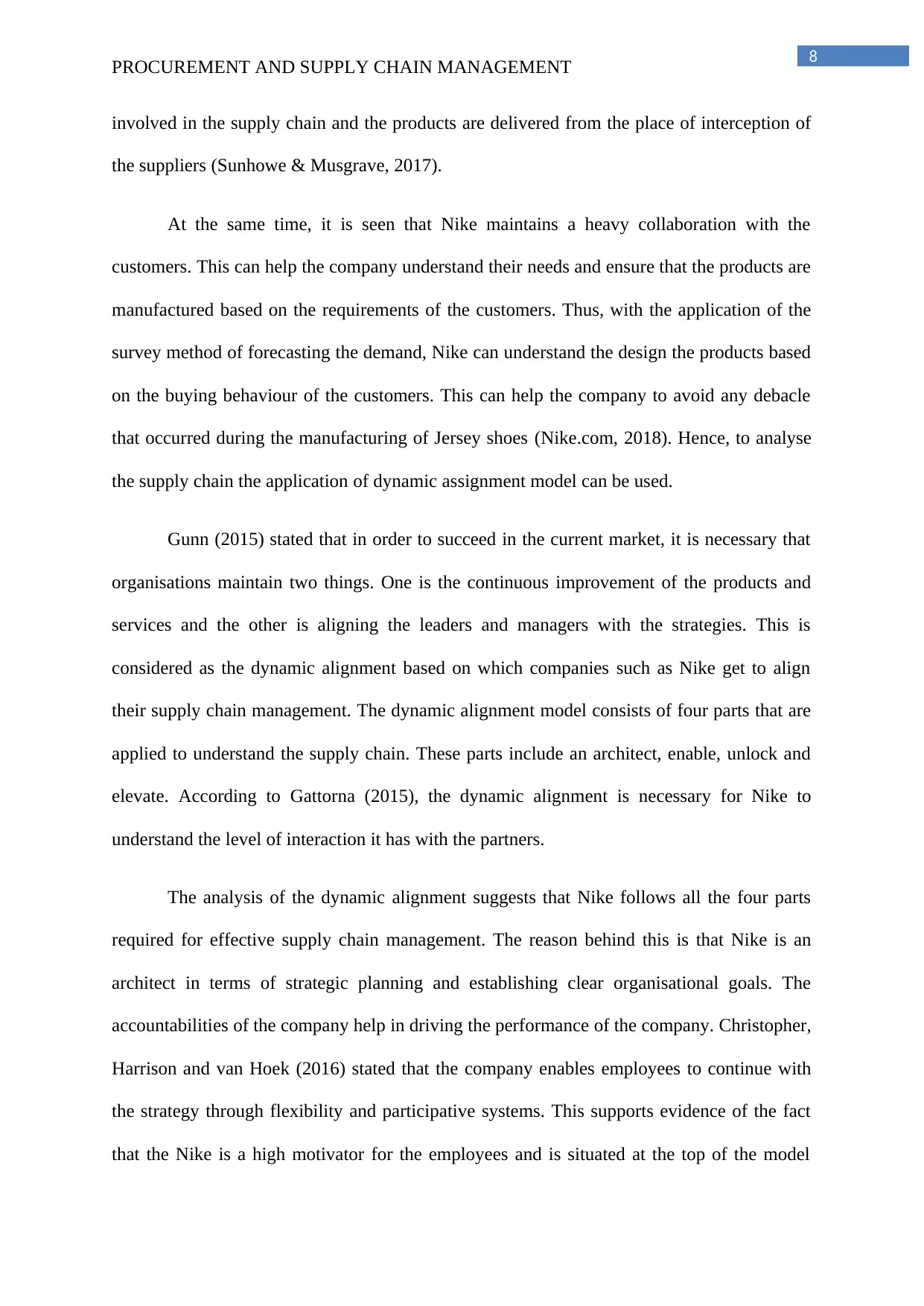
8
PROCUREMENT AND SUPPLY CHAIN MANAGEMENT
involved in the supply chain and the products are delivered from the place of interception of
the suppliers (Sunhowe & Musgrave, 2017).
At the same time, it is seen that Nike maintains a heavy collaboration with the
customers. This can help the company understand their needs and ensure that the products are
manufactured based on the requirements of the customers. Thus, with the application of the
survey method of forecasting the demand, Nike can understand the design the products based
on the buying behaviour of the customers. This can help the company to avoid any debacle
that occurred during the manufacturing of Jersey shoes (Nike.com, 2018). Hence, to analyse
the supply chain the application of dynamic assignment model can be used.
Gunn (2015) stated that in order to succeed in the current market, it is necessary that
organisations maintain two things. One is the continuous improvement of the products and
services and the other is aligning the leaders and managers with the strategies. This is
considered as the dynamic alignment based on which companies such as Nike get to align
their supply chain management. The dynamic alignment model consists of four parts that are
applied to understand the supply chain. These parts include an architect, enable, unlock and
elevate. According to Gattorna (2015), the dynamic alignment is necessary for Nike to
understand the level of interaction it has with the partners.
The analysis of the dynamic alignment suggests that Nike follows all the four parts
required for effective supply chain management. The reason behind this is that Nike is an
architect in terms of strategic planning and establishing clear organisational goals. The
accountabilities of the company help in driving the performance of the company. Christopher,
Harrison and van Hoek (2016) stated that the company enables employees to continue with
the strategy through flexibility and participative systems. This supports evidence of the fact
that the Nike is a high motivator for the employees and is situated at the top of the model
PROCUREMENT AND SUPPLY CHAIN MANAGEMENT
involved in the supply chain and the products are delivered from the place of interception of
the suppliers (Sunhowe & Musgrave, 2017).
At the same time, it is seen that Nike maintains a heavy collaboration with the
customers. This can help the company understand their needs and ensure that the products are
manufactured based on the requirements of the customers. Thus, with the application of the
survey method of forecasting the demand, Nike can understand the design the products based
on the buying behaviour of the customers. This can help the company to avoid any debacle
that occurred during the manufacturing of Jersey shoes (Nike.com, 2018). Hence, to analyse
the supply chain the application of dynamic assignment model can be used.
Gunn (2015) stated that in order to succeed in the current market, it is necessary that
organisations maintain two things. One is the continuous improvement of the products and
services and the other is aligning the leaders and managers with the strategies. This is
considered as the dynamic alignment based on which companies such as Nike get to align
their supply chain management. The dynamic alignment model consists of four parts that are
applied to understand the supply chain. These parts include an architect, enable, unlock and
elevate. According to Gattorna (2015), the dynamic alignment is necessary for Nike to
understand the level of interaction it has with the partners.
The analysis of the dynamic alignment suggests that Nike follows all the four parts
required for effective supply chain management. The reason behind this is that Nike is an
architect in terms of strategic planning and establishing clear organisational goals. The
accountabilities of the company help in driving the performance of the company. Christopher,
Harrison and van Hoek (2016) stated that the company enables employees to continue with
the strategy through flexibility and participative systems. This supports evidence of the fact
that the Nike is a high motivator for the employees and is situated at the top of the model
⊘ This is a preview!⊘
Do you want full access?
Subscribe today to unlock all pages.

Trusted by 1+ million students worldwide

9
PROCUREMENT AND SUPPLY CHAIN MANAGEMENT
proposed by Trigger. At the same time, the company can unlock workforce potential and
sustain the ability of the employees in an appropriate manner.
Lee, Padmanabhan and Whang (2015) stated that the cause and remedy of the
bullwhip effect suggest that the enthusiasm of the employees of Nike ensures that the leaders
meet the required achievement of the company. This can help in elevating the leadership and
ensure that the leaders value the model that promotes a culture driven by a partnership. The
partnership of the company with the suppliers and customers suggest that Nike belongs to a
mid-way hierarchical group that focuses on the effectiveness of the supply chain
management. Thus, a process of improvement can be suggested so that Nike can maintain its
stronghold in the business market.
Figure: Dynamic alignment model
(Source: Jabbarzadeh, Fahimnia & Seuring, 2014)
PROCUREMENT AND SUPPLY CHAIN MANAGEMENT
proposed by Trigger. At the same time, the company can unlock workforce potential and
sustain the ability of the employees in an appropriate manner.
Lee, Padmanabhan and Whang (2015) stated that the cause and remedy of the
bullwhip effect suggest that the enthusiasm of the employees of Nike ensures that the leaders
meet the required achievement of the company. This can help in elevating the leadership and
ensure that the leaders value the model that promotes a culture driven by a partnership. The
partnership of the company with the suppliers and customers suggest that Nike belongs to a
mid-way hierarchical group that focuses on the effectiveness of the supply chain
management. Thus, a process of improvement can be suggested so that Nike can maintain its
stronghold in the business market.
Figure: Dynamic alignment model
(Source: Jabbarzadeh, Fahimnia & Seuring, 2014)
Paraphrase This Document
Need a fresh take? Get an instant paraphrase of this document with our AI Paraphraser
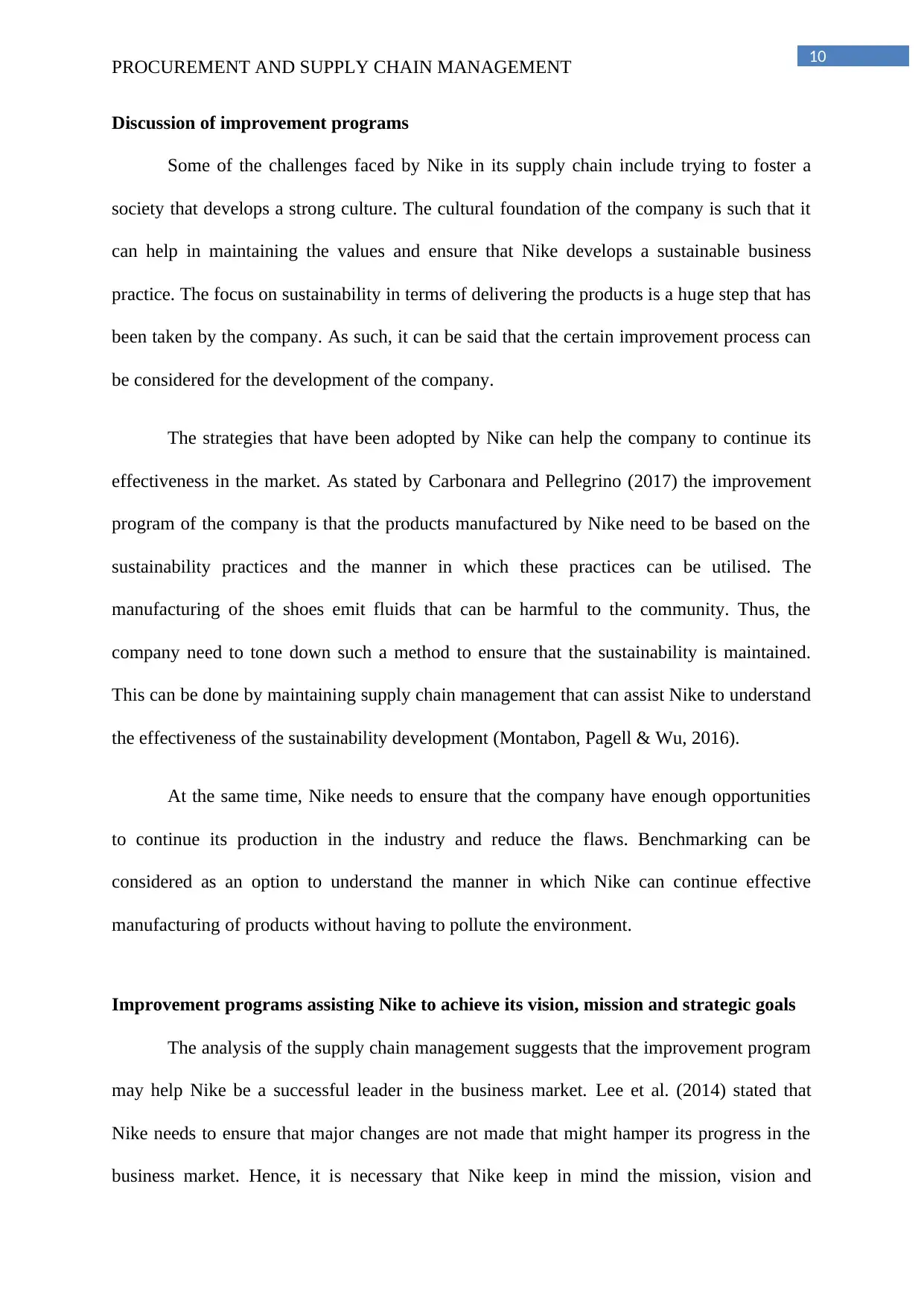
10
PROCUREMENT AND SUPPLY CHAIN MANAGEMENT
Discussion of improvement programs
Some of the challenges faced by Nike in its supply chain include trying to foster a
society that develops a strong culture. The cultural foundation of the company is such that it
can help in maintaining the values and ensure that Nike develops a sustainable business
practice. The focus on sustainability in terms of delivering the products is a huge step that has
been taken by the company. As such, it can be said that the certain improvement process can
be considered for the development of the company.
The strategies that have been adopted by Nike can help the company to continue its
effectiveness in the market. As stated by Carbonara and Pellegrino (2017) the improvement
program of the company is that the products manufactured by Nike need to be based on the
sustainability practices and the manner in which these practices can be utilised. The
manufacturing of the shoes emit fluids that can be harmful to the community. Thus, the
company need to tone down such a method to ensure that the sustainability is maintained.
This can be done by maintaining supply chain management that can assist Nike to understand
the effectiveness of the sustainability development (Montabon, Pagell & Wu, 2016).
At the same time, Nike needs to ensure that the company have enough opportunities
to continue its production in the industry and reduce the flaws. Benchmarking can be
considered as an option to understand the manner in which Nike can continue effective
manufacturing of products without having to pollute the environment.
Improvement programs assisting Nike to achieve its vision, mission and strategic goals
The analysis of the supply chain management suggests that the improvement program
may help Nike be a successful leader in the business market. Lee et al. (2014) stated that
Nike needs to ensure that major changes are not made that might hamper its progress in the
business market. Hence, it is necessary that Nike keep in mind the mission, vision and
PROCUREMENT AND SUPPLY CHAIN MANAGEMENT
Discussion of improvement programs
Some of the challenges faced by Nike in its supply chain include trying to foster a
society that develops a strong culture. The cultural foundation of the company is such that it
can help in maintaining the values and ensure that Nike develops a sustainable business
practice. The focus on sustainability in terms of delivering the products is a huge step that has
been taken by the company. As such, it can be said that the certain improvement process can
be considered for the development of the company.
The strategies that have been adopted by Nike can help the company to continue its
effectiveness in the market. As stated by Carbonara and Pellegrino (2017) the improvement
program of the company is that the products manufactured by Nike need to be based on the
sustainability practices and the manner in which these practices can be utilised. The
manufacturing of the shoes emit fluids that can be harmful to the community. Thus, the
company need to tone down such a method to ensure that the sustainability is maintained.
This can be done by maintaining supply chain management that can assist Nike to understand
the effectiveness of the sustainability development (Montabon, Pagell & Wu, 2016).
At the same time, Nike needs to ensure that the company have enough opportunities
to continue its production in the industry and reduce the flaws. Benchmarking can be
considered as an option to understand the manner in which Nike can continue effective
manufacturing of products without having to pollute the environment.
Improvement programs assisting Nike to achieve its vision, mission and strategic goals
The analysis of the supply chain management suggests that the improvement program
may help Nike be a successful leader in the business market. Lee et al. (2014) stated that
Nike needs to ensure that major changes are not made that might hamper its progress in the
business market. Hence, it is necessary that Nike keep in mind the mission, vision and
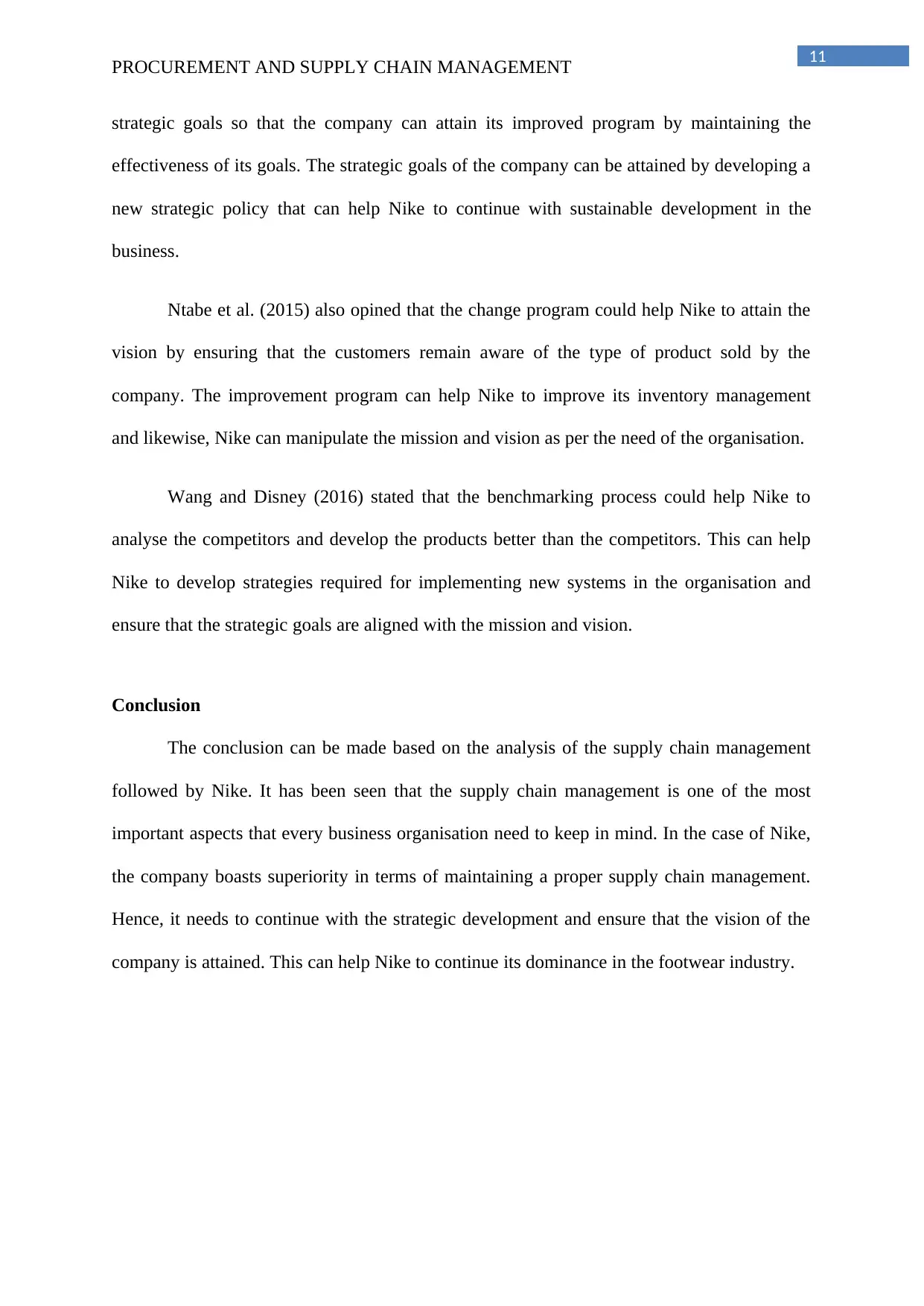
11
PROCUREMENT AND SUPPLY CHAIN MANAGEMENT
strategic goals so that the company can attain its improved program by maintaining the
effectiveness of its goals. The strategic goals of the company can be attained by developing a
new strategic policy that can help Nike to continue with sustainable development in the
business.
Ntabe et al. (2015) also opined that the change program could help Nike to attain the
vision by ensuring that the customers remain aware of the type of product sold by the
company. The improvement program can help Nike to improve its inventory management
and likewise, Nike can manipulate the mission and vision as per the need of the organisation.
Wang and Disney (2016) stated that the benchmarking process could help Nike to
analyse the competitors and develop the products better than the competitors. This can help
Nike to develop strategies required for implementing new systems in the organisation and
ensure that the strategic goals are aligned with the mission and vision.
Conclusion
The conclusion can be made based on the analysis of the supply chain management
followed by Nike. It has been seen that the supply chain management is one of the most
important aspects that every business organisation need to keep in mind. In the case of Nike,
the company boasts superiority in terms of maintaining a proper supply chain management.
Hence, it needs to continue with the strategic development and ensure that the vision of the
company is attained. This can help Nike to continue its dominance in the footwear industry.
PROCUREMENT AND SUPPLY CHAIN MANAGEMENT
strategic goals so that the company can attain its improved program by maintaining the
effectiveness of its goals. The strategic goals of the company can be attained by developing a
new strategic policy that can help Nike to continue with sustainable development in the
business.
Ntabe et al. (2015) also opined that the change program could help Nike to attain the
vision by ensuring that the customers remain aware of the type of product sold by the
company. The improvement program can help Nike to improve its inventory management
and likewise, Nike can manipulate the mission and vision as per the need of the organisation.
Wang and Disney (2016) stated that the benchmarking process could help Nike to
analyse the competitors and develop the products better than the competitors. This can help
Nike to develop strategies required for implementing new systems in the organisation and
ensure that the strategic goals are aligned with the mission and vision.
Conclusion
The conclusion can be made based on the analysis of the supply chain management
followed by Nike. It has been seen that the supply chain management is one of the most
important aspects that every business organisation need to keep in mind. In the case of Nike,
the company boasts superiority in terms of maintaining a proper supply chain management.
Hence, it needs to continue with the strategic development and ensure that the vision of the
company is attained. This can help Nike to continue its dominance in the footwear industry.
⊘ This is a preview!⊘
Do you want full access?
Subscribe today to unlock all pages.

Trusted by 1+ million students worldwide
1 out of 15
Related Documents
Your All-in-One AI-Powered Toolkit for Academic Success.
+13062052269
info@desklib.com
Available 24*7 on WhatsApp / Email
![[object Object]](/_next/static/media/star-bottom.7253800d.svg)
Unlock your academic potential
Copyright © 2020–2025 A2Z Services. All Rights Reserved. Developed and managed by ZUCOL.




